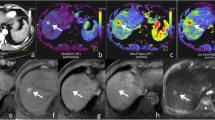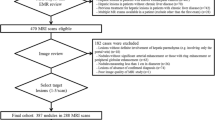Abstract
The study object was to retrospectively compare the detection rate of hypervascular foci visualized by CT during hepatic arteriography (CTHA) in borderline nodules, which was observed upon cirrhotic livers, on dynamic MDCT, dynamic gadolinium-enhanced MR (dynamic MR), and SPIO-enhanced MR imaging. Eighty-five nodules in 49 patients with cirrhosis were evaluated. When a part of the nodule showed hyperdensity relative to the surrounding areas of the nodule on CTHA, it was defined as “hypervascular focus.” The relationships between the dynamic MDCT and dynamic MR and SPIO-enhanced MR imaging findings of these foci were analyzed using X2 test. Hypervascular foci were detected in 17 (53%) of 32 on the arterial dominant phase of dynamic MDCT, in 19 (37%) of 51 on the arterial dominant phase of dynamic MR and in 6 (26%) of 23 on SPIO-enhanced MR imaging. Arterial dominant phase of dynamic MDCT demonstrated a significantly higher detection rate of hypervascular foci less than 5 mm in diameter than did dynamic and SPIO MR imaging (p<0.05). Hypervascular foci in borderline nodules could be better visualized by dynamic MDCT than by gadolinium- and SPIO-enhanced MR imaging. Dynamic MDCT is recommended for the follow-up examination of hypovascular borderline lesions.





Similar content being viewed by others
References
Sakamoto M, Hirohashi S, Shimosato Y (1991) Early stage of multistep hepatocarcinogenesis: adenomatous hyperplasia and early hepatocellular carcinoma. Hum Pathol 22:172–178
Matsui O, Kadoya M, Kameyama T et al (1991) Benign and malignant nodules in cirrhotic livers: distinction based on blood supply. Radiology 178:493–497
Kudo M, Tomita S, Kashida H et al (1991) Tumor hemodynamics in hepatic nodules associated with liver cirrhosis: relationship between cancer progression and tumor hemodynamic change (in Japanese). Nippon Shokakibyo Gakkai Zasshi 88:1554–1565
Sakamoto M, Ino Y, Fujii T et al (1993) Phenotype changes in tumor vessels associated with the progression of hepatocellular carcinoma. Jpn JClin Oncol 23:98–104
Ueda K, Terada T, Nakanuma Y, Matsui O (1992) Vascular supply in adenomatous hyperplasia of the liver and hepatocellular carcinoma: a morphometric study. Hum Pathol 23:619–26
Liver Cancer Study Group of Japan (1992) The general rules for the clinical and pathological study of primary liver cancer, 3rd edn. Kanahara, Tokyo, pp 32–39
International Working Party (1995) Terminology of nodular hepatocellular lesions. Hepatology 22:983–993
Sakamoto M, Hirohashi S, Tsuda H et al (1989) Multicentric independent development of hepatocellular carcinoma revealed by analysis of hepatitis B virus integration pattern. Am J Surg Pathol 13:1064–1067
Matsui O, Kadoya M, Kameyama T, Yoshikawa J, Arai K, Gabata T, Takashima T, Nakanuma Y, Terada T, Ida M (1989) Adenomatous hyperplastic nodules in the cirrhotic liver: differentiation from hepatocellular carcinoma with MR imaging. Radiology 173:123–6
Hayashi M, Matsui O, Ueda K et al (1999) Correlation between the blood supply and grade of malignancy of hepatocellular nodules associated with liver cirrhosis: evaluation by CT during intraarterial injection of contrast medium. AJR 172:969–976
Hayashi M, Matsui O, Ueda K et al (2002) Progression to hypervascular hepatocellular carcinoma: Correlation with intranodular blood supply evaluated with CT during intraarterial injection of contrast material. Radiology 225:143–9
Nakanuma Y, Terada T, Terasaki S et al (1990) Atypical adenomatous hyperplasia in liver cirrhosis: low-grade hepatocellular carcinoma or borderline lesion? Histopathology 17:27–35
Sakamoto M, Hirohashi S, Tsuda H et al (1989) Multicentric independent development of hepatocellular carcinoma revealed by analysis of hepatitis B virus integration pattern. Am J Surg Pathol 13:1064–1067
Liver Cancer Study Group of Japan (2000) The general rules for the clinical and pathological study of primary liver cancer, 4th edn. Tokyo, Kanahara, pp 30–34
International Working Party (1995) Terminology of nodular hepatocellular lesions. Hepatology 22:983–993
Nakanuma Y, Hirata K, Terasaki S, Ueda K, Matsui O (1998) Analytical histopathological diagnosis of small hepatocellular nodules in chronic liver diseases. Histol Histopathol 13:1077–1087
Krinsky GA, Lee VS, Theise ND et al (2001) Hepatocellular carcinoma and dysplastic nodules in patients with cirrhosis: prospective diagnosis with MR imaging and explantation correlation. Radiology 219:445–454
Amelie ML, Jurgen KW, Kerstin Goepfert RT et al (2005) Hepatocellular carcinoma in cirrhosis: Enhancement patterns at dynamic gadolinium-and superparamagnetic iron oxide-enhanced T1-weighted MR Imaging. Radiology 237:520–528
Goshima S, Kanematsu M, Matsuo M et al (2004) Nodule-in-nodule appearance of hepatocellular carcinoma: Comparison of gadolinium-enhanced and fermoxides-enhanced magnetic resonance imaging. J Magn Reson Imaging 20:250–255
Author information
Authors and Affiliations
Corresponding author
Rights and permissions
About this article
Cite this article
Shinmura, R., Matsui, O., Kadoya, M. et al. Detection of hypervascular malignant foci in borderline lesions of hepatocellular carcinoma: comparison of dynamic multi-detector row CT, dynamic MR imaging and superparamagnetic iron oxide-enhanced MR imaging. Eur Radiol 18, 1918–1924 (2008). https://doi.org/10.1007/s00330-008-0954-5
Received:
Revised:
Accepted:
Published:
Issue Date:
DOI: https://doi.org/10.1007/s00330-008-0954-5




